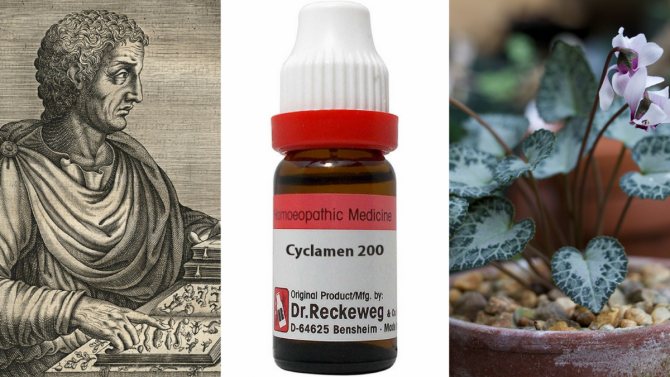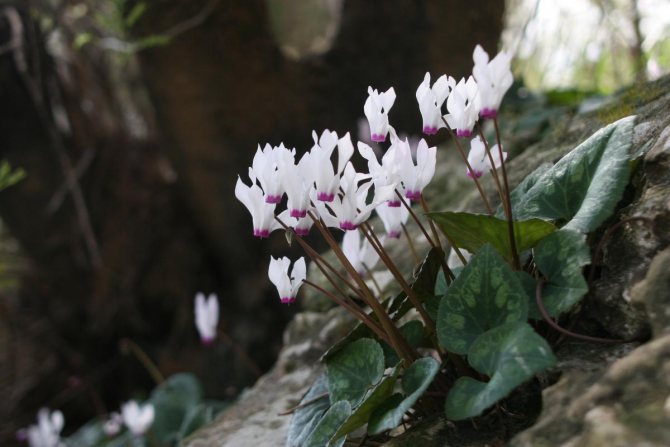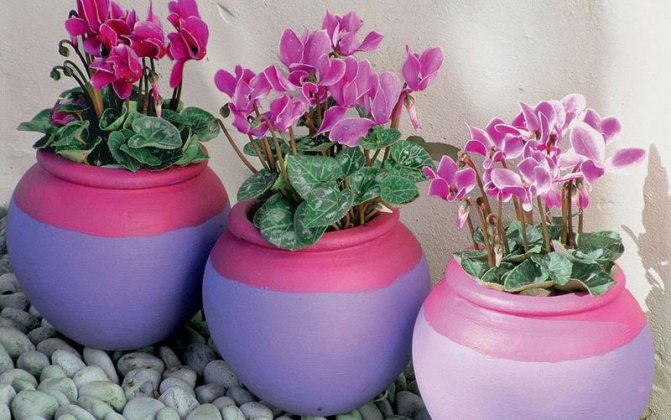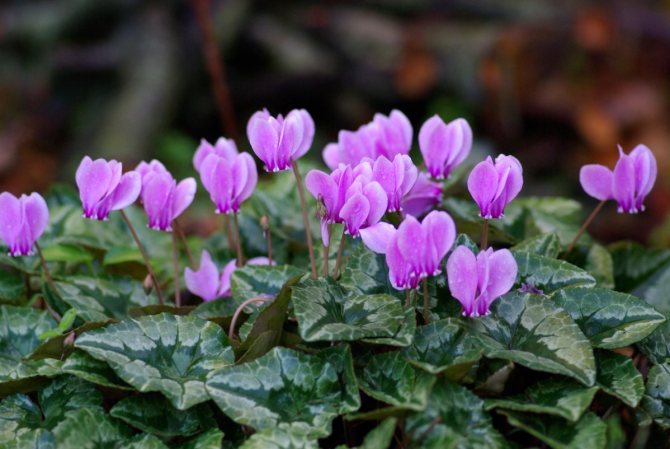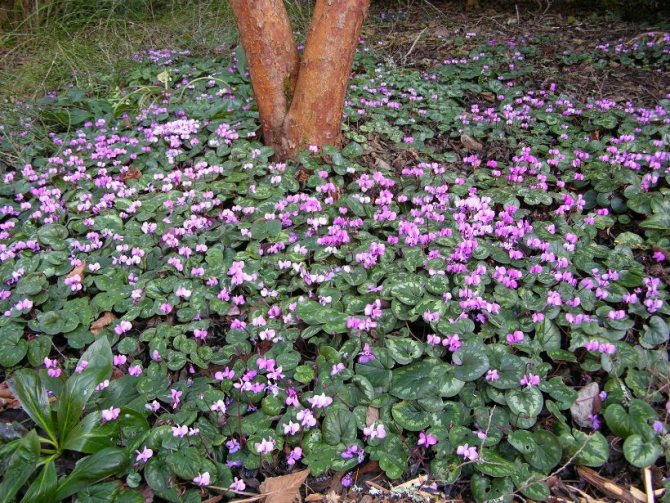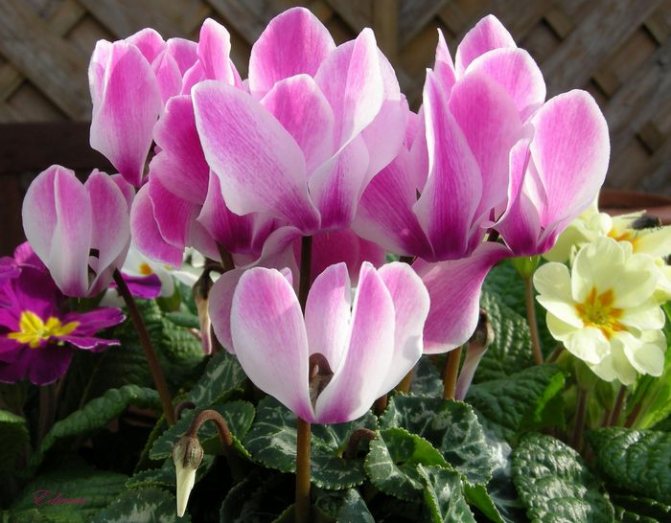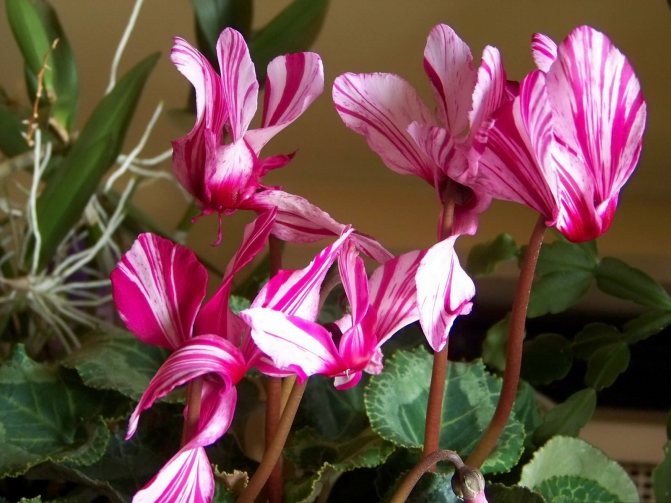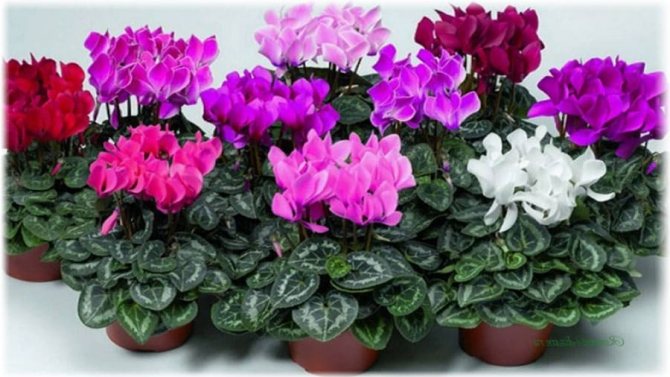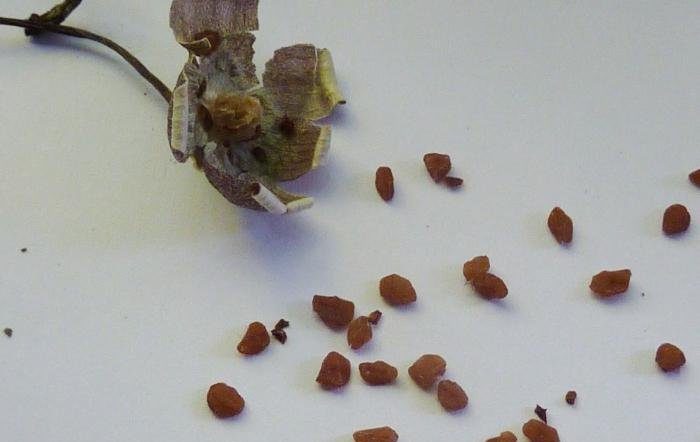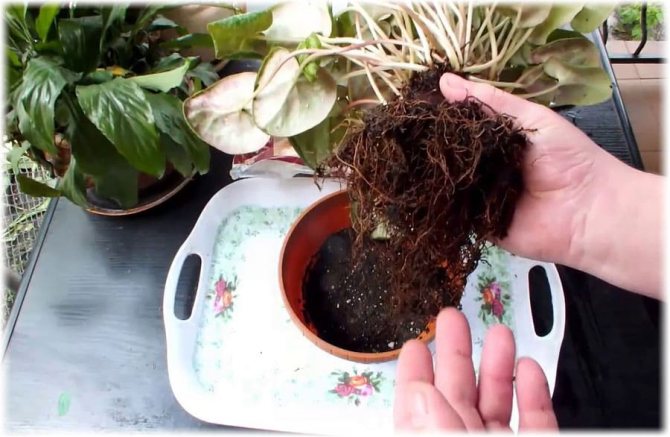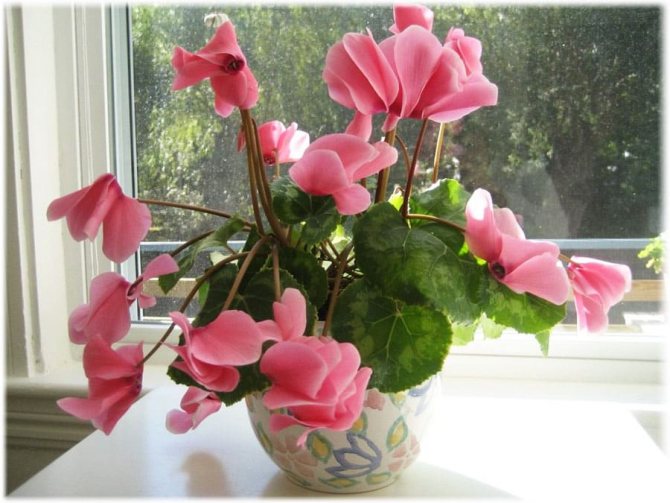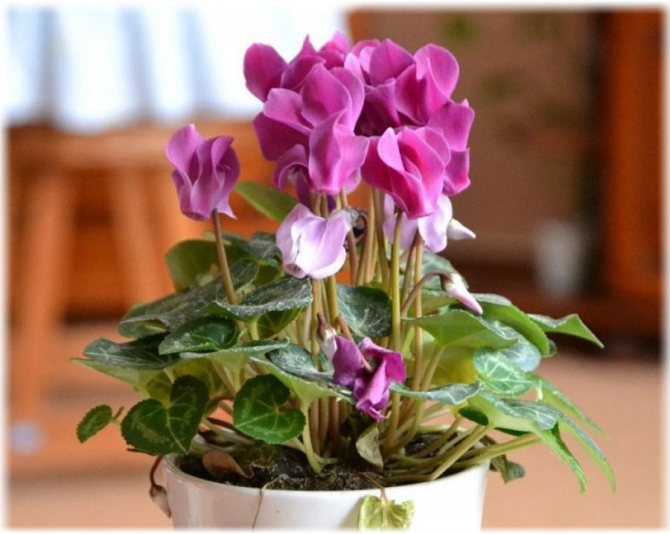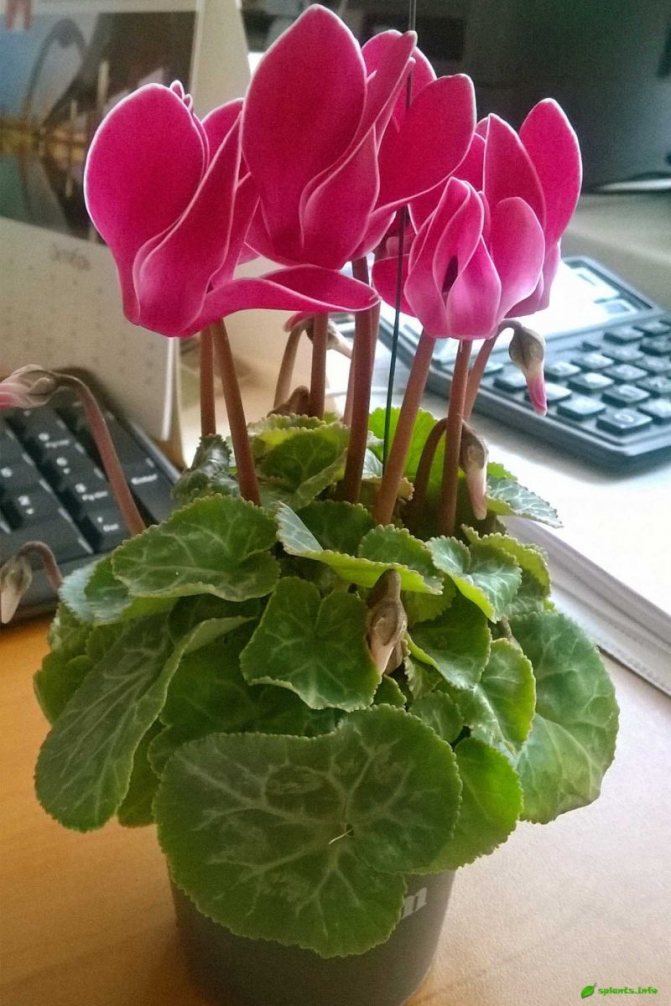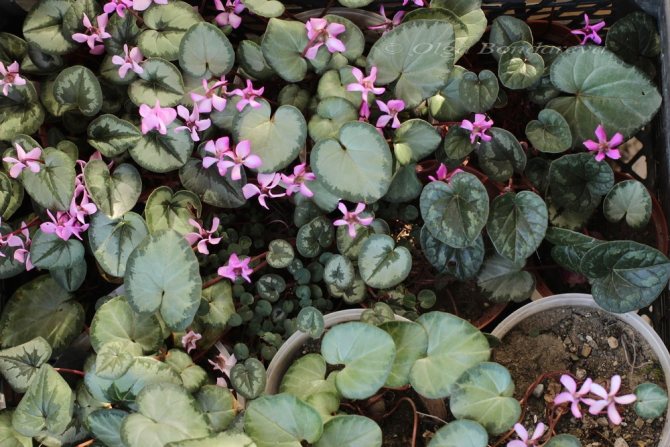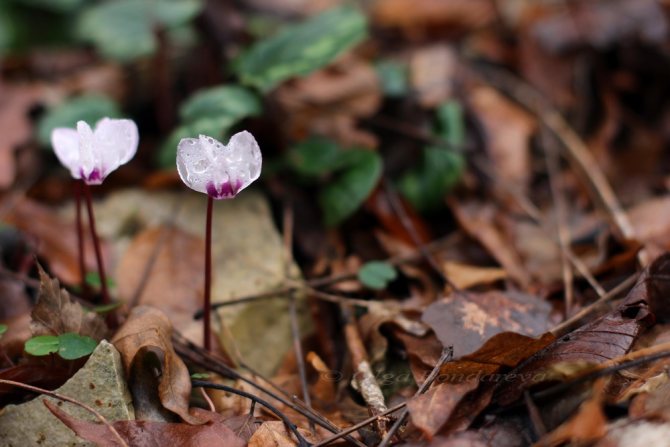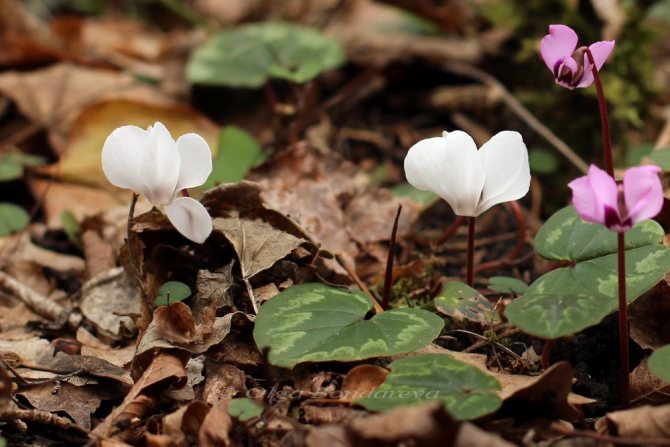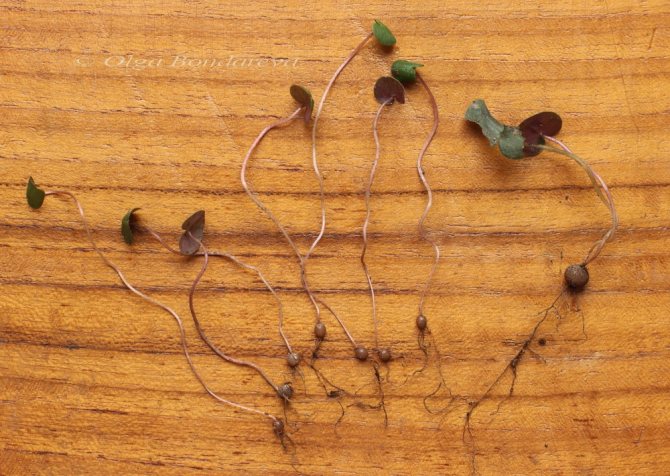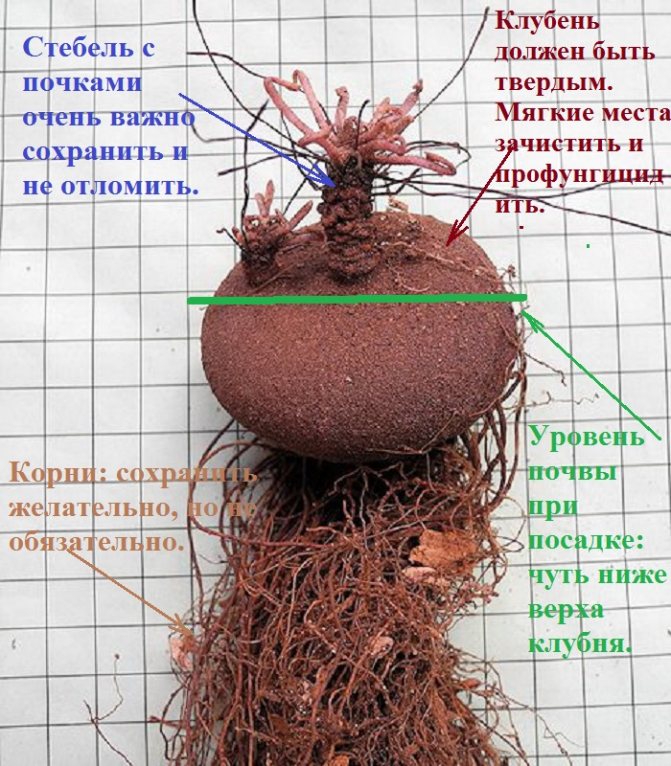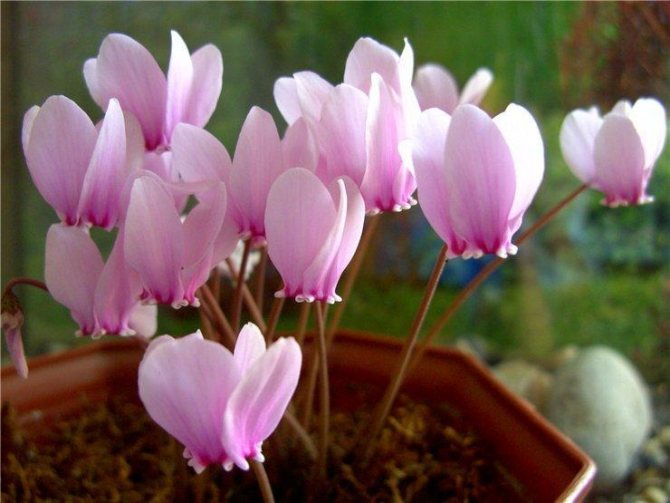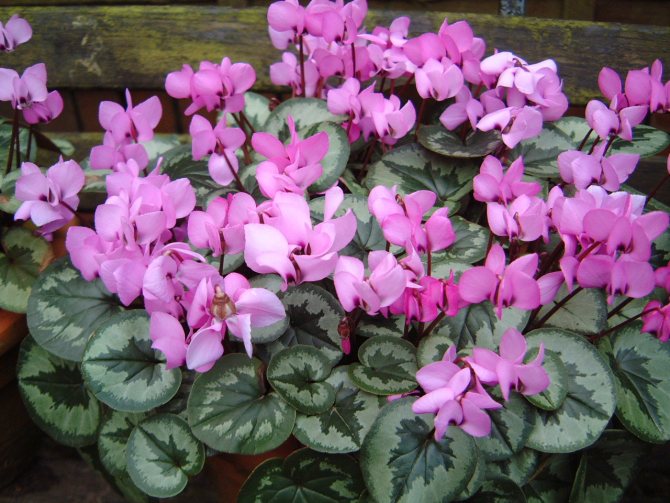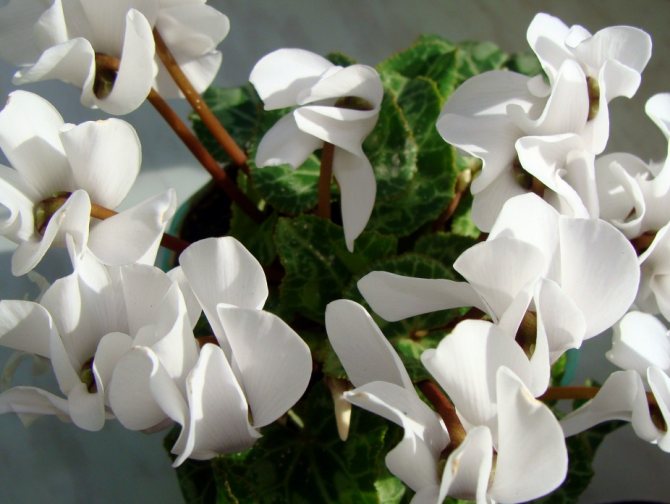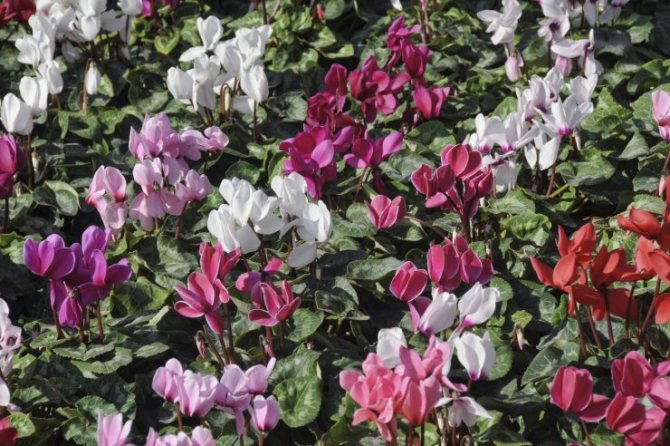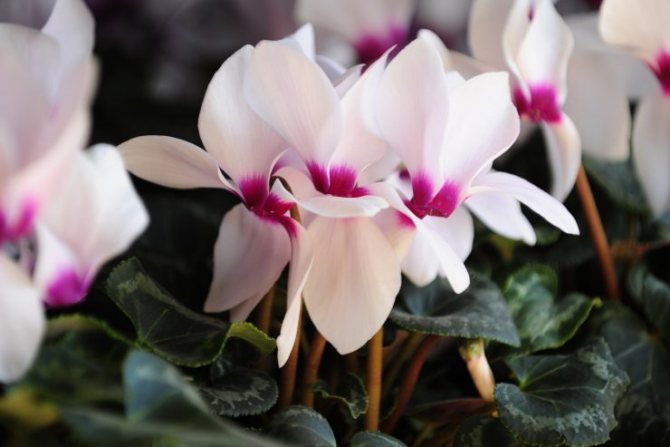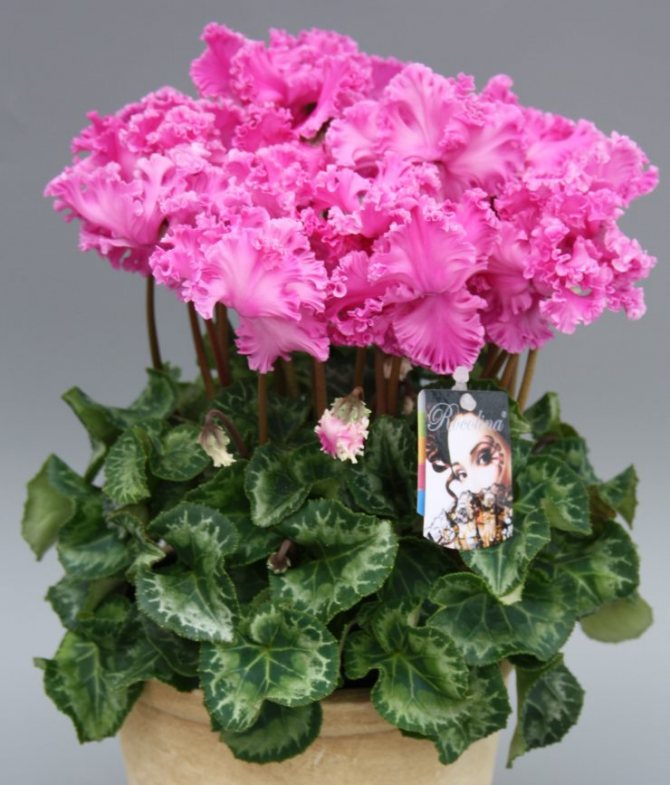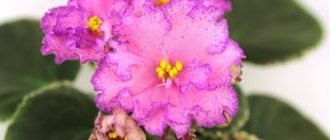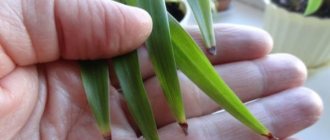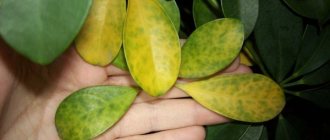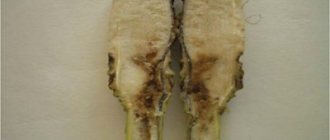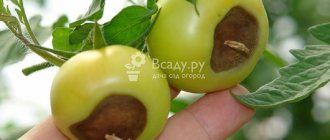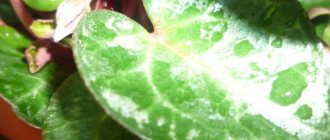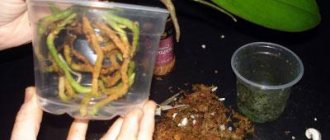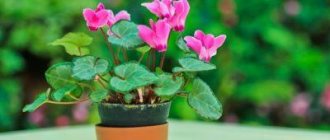Description of European cyclamen.
It is a perennial herb with globular, flattened, thick tubers, purple or dark brown in color. Cyclamen european is a medicinal plant from the primrose family. Leaves are long-petiolate, basal, rounded-ovate with a greenish-silvery pattern. Flowers drooping, solitary, with a pale purple-pink corolla. The fruit is an ovoid or spherical capsule. Cyclamen blooms in early spring.
Cyclamen European photo.
Where does the European cyclamen grow?
The medicinal plant cyclamen European (Cyclamen europaeum L.) grows in the mountain forests of the Caucasus and Crimea. On the territory of Ukraine it is cultivated as an ornamental plant in open ground in gardens. European cyclamen and Persian cyclamen are known as indoor plants.
How to distinguish a Persian from a European cyclamen?
The Persian cyclamen does not smell flowers, while the European cyclamen does. The Persian cyclamen has roots only from the bottom of the tuber, while the European cyclamen has roots around the tuber and, moreover, it gives birth to children. European cyclamen blooms only in season.
Harvesting of European cyclamen.
Roots are subject to harvesting.
The chemical composition of European cyclamen.
The tubers of the plant contain the poisonous saponin cyclamin, which, upon interaction with water, decomposes into cyclamyretin, amorphous sapotenin, mulosin, sugar, dextrose, cyclose, the polysaccharide cyclamosin and pentose.
Medicinal properties and use of European cyclamen.
An aqueous infusion of cyclamen roots is used in violation of the cycle of menstruation, diseases of female organs, headaches, neuralgia, flatulence, liver disease, rheumatism, colds, intestinal colic, sinusitis, intestinal colic, gout, rheumatism.
The preparations of the medicinal plant cyclamen European are very effective for sinusitis, frontal sinusitis and headaches resulting from colds.
For treatment with a European cyclamen, the patient is seated, their heads are thrown back, 1 - 2 drops of pure fresh juice from the roots of the plant are instilled into the nose. So he should sit for 5 minutes, then go to bed. After 10 minutes, he begins to cough, sneeze, sweat, and mucus from the nose. This happens for many hours. The patient falls asleep, and wakes up in the morning feels good.
Hot infusion is also used in folk medicine. For this, 1 tbsp. l. chopped tubers are filled with 2 glasses of hot water. It turns out a dose for 2 days. Take 1 tbsp. l. warm infusion three times a day after meals.
A tincture is also prepared from 1 gram of roots per 10 g of alcohol. Insist for a week. Take 30 drops of tincture 2 - 3 times a day.
Contraindications of European cyclamen.
All types of cyclamen are poisonous, so using it inside requires caution. Talk to your doctor about taking cyclamen.
Caroline
Cyclamen is a perennial plant of the primrose family, it has about 20 species. The distribution of cyclamen in the wild is quite extensive.
Where does cyclamen come from?
Indoor cyclamens are Persian and European species. The homeland of the indoor European cyclamen is Spain and Central Europe.Northeast Africa and Iran, as well as Turkey and the countries of the Middle East, are called homeland. Sometimes some wild species of cyclamen are found in the foothills of the Caucasus and in the Crimea.
Conditions in the homeland of the cyclamen flower are rather harsh, so the plant is accustomed to difficulties - poor soil and cool nights. In general, in the wild, cyclamens grow in groups in the shade of deciduous forests or on mountain slopes. Therefore, they prefer coolness and diffused light at home.
The history of the spread of cyclamen
For the first time in Europe, the cyclamen was found in the 17th century by wild pigs who liked to feast on its tubers. And only in the middle of the 19th century in England the flower began to be grown as an ornamental plant. In greenhouses, it was planted along with exotic plants.
As indoor flowers, cyclamens were cultivated by the French back in 1731. At first, the cyclamen had tiny white flowers, and only thanks to the painstaking work of flower growers and breeders did it gain recognition for having posh hybrid varieties that spread throughout the world.
Today, the variety of colors and shapes of inflorescences of this amazing flower is simply amazing. Breeders show their imagination, creating hybrids with corrugated and multi-colored frills, border, two-color inflorescences.
It is safe to say that if a cyclamen appears on your windowsill or in a greenhouse, you will unconditionally and forever fall in love with this beautiful and fragrant flower.
Caucasian cyclamen is a beautiful plant that is actively used in folk medicine. It is listed in the Red Book of the Krasnodar Territory and is carefully guarded by government agencies. If the dosage is observed, it can have a positive effect on the digestive system, restore strength after colds.
Caucasian cyclamen is a beautiful plant that lives not only in the wild. People fell in love with it for a long time and is successfully grown on windowsills. Cyclamen can be a good holiday gift. He belongs to the Mirsinov family. The plant got its unusual name for the shape of the rhizomes, which are in the shape of a circle. Translated from Greek, the word "kyklos" means "circle". Cyclamen is comfortable both in dense forests and near the mountains. In total, there are up to 50 varieties of this plant. About 10 of them live in the Caucasus.
Description of the plant
The cyclamen is small in size, reaching no more than 20 cm in height. Large roots are visible from the ground. When purchasing a new plant, pay attention to the appearance of the root system. The leaves are voluminous, hold on to the trunk with petioles. As a rule, they are egg-shaped and can be marbled in color. Cyclamen produces flowers on long, thin peduncles. The first flowering begins in early April. The whisk looks down. Flowers range from white to dark pink. The petals are turned outward. At the end of flowering, the box with ripe fruits drops to the ground, where a new flower grows. Therefore, cyclamens grow in groups. The entire ground part dies off by the end of summer along with the flowers, but in the fall new leaves grow, which grow all winter.
Beneficial features
Despite the fact that cyclamen is listed in the Red Book of the Krasnodar Territory, it is actively used in folk medicine. Infusions help with colds, diseases of the digestive system. It is strictly prohibited to be treated with cyclamen on its own. This is due to the high concentration of the poison in the composition. Your doctor will help you calculate the correct dosage. An excess of certain substances can lead to dizziness, nausea, vomiting, and seizures.
If you want something unusual and very bright in your apartment or house, then choose for this a plant that has fragrant beautiful flowers - cyclamen. How to care for it and how to reproduce is not a very difficult question, but still requires effort.If you want to see greenery all year round, then European cyclamen is best suited, if bright and abundant flowering, then Persian. And in either case, even a not very experienced florist can handle the cultivation. In addition to high decorative qualities, medicinal properties are also characteristic of cyclamen. Its use in medicine has been practiced since the time of Hippocrates. Cyclamen is also called the flower of King Solomon. According to legend, he hesitated for a long time about which shape to choose for his crown. Many options were tried, but by pure chance, a modest cyclamen appeared in front of the ruler's gaze, which he really liked, it was the shape of his flower that Solomon gave preference to.
Varieties
Indoor cyclamen belongs, as a rule, to one of the two most common types: Persian or European. Both of them are very decorative, but differ slightly both in appearance and in how to grow cyclamen. Persian is sometimes also called alpine violet. It is very graceful, it has decorative not only flowers, but also leaves. The plant has a dormant period. It can reach sizes large enough for a houseplant - up to 30 cm in height. He is the progenitor of most modern species.
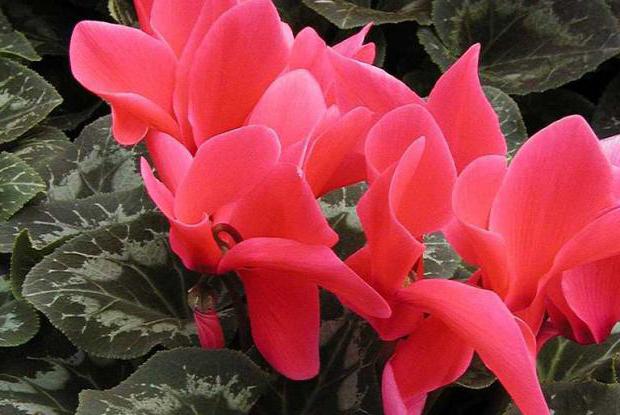
The European cyclamen is simpler in room culture. In winter, it does not shed leaves and retains its greenery throughout the year. But the size is much smaller, while the flowers have a beautiful, most often pinkish color and a delicate pleasant aroma. This variety is primarily suitable for those who are just starting their acquaintance with cyclamen. He is quite simple to grow and tenacious, if suddenly the created conditions do not suit him. In addition to these two species, there is one more - this is the Caucasian cyclamen, however, it is very rare to meet it in our apartments. It grows on the slopes of the mountains, the flowers are white or sometimes pale pink. It belongs to early flowering plants and pleases with bright colors already from February, as soon as the first thawed patches begin to appear.
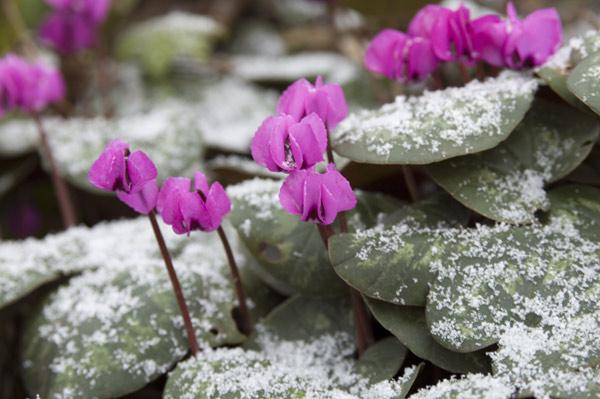

The root, like other species, is a rounded tuber. It is mainly used at home as a primrose garden plant. Caucasian cyclamen is listed in the Red Book of the Russian Federation as a vulnerable species, the number of which is steadily decreasing.
What is this plant?
The cyclamen has an interesting root shape. It is a flattened corm of the correct round shape. Its diameter is 15 cm. There is one growth point on it, and not several, as in other indoor plants. How can you characterize the leaves? They are leathery, basal and heart-shaped. They grow on petioles, the length of which is 30 cm. The color of the leaves is dark green, and the pattern on them is grayish-silver.
When flowering on the cyclamen, the buds of the original form open. From the side it seems that strange butterflies perched on top of the leaves on the peduncles. Why does this impression appear? Because the buds are pointed and folded back. They have a fringed shape. Depending on the type of cyclamen, flowers can be purple, red and burgundy. Duration of flowering is 3 months.
Attention! Although some growers consider cyclamen to be capricious, in fact it is not like that. It's just important to follow some of the care requirements, and it won't be a hassle.
Cyclamen: the birthplace of the plant
It is safe to name four points on our planet from where this flower spread: Asia Minor, Iran, Central Europe and the Mediterranean. The growing area is wide enough, it grows in the foothill areas, at the edges of the forest. As a cultivated garden plant, cyclamen has been mentioned since 1731, but it began to gain immense popularity only when breeders got involved.By creating stunning varieties with large double or simple flowers of various shades, they have provided him with fame for a long time. Persian cyclamen is especially common in our stores. The homeland of the plant is Asia Minor and Greece, where it grows in open ground and in the spring you can come across whole glades, fragrant with a very strong aroma. Due to the fact that it blooms closer to Christmas, it is grown on an industrial scale in Europe, especially in Germany, Holland, Italy and France. And not only as a houseplant, but also for loggias, patios and gardens. But its own, closer European cyclamen (the plant's homeland is Central Europe) is not so common. Although it is easier to grow it.
general description
Cyclamen, or alpine violet, is a perennial bulbous plant of the primrose family. It has large, patterned, heart-shaped leaves and single five-petalled flowers located on long pedicels.
The diameter of each flower reaches 8 cm. Their color depends on the type and variety of cyclamen. Flower petals can be simple or double. The flowers of the plant tend to lift the petals up as they bloom, due to which, during flowering, the cyclamen looks as if many butterflies have descended on it.
The plant has a pleasant delicate smell, which is actively used in perfumery.
In the wild, cyclamens grow in places where a warm and humid climate prevails: in the Mediterranean, in the Middle East, in Northeast Africa, in the Caucasus.
Place in the house and lighting
Although the homeland of indoor cyclamen is the warm edges of the Mediterranean, it still prefers diffused light, without direct sunlight. If you put it on the floor, then it is likely to be visually lost, so the best place would be the western and eastern windows in the house or special flower racks in a slightly shaded place. Indoor cyclamen is extremely demanding on temperature conditions. This is its peculiarity and one of the nuances of growing. The temperature in summer should be in the range of 18-25 degrees, and in winter the most optimal and favorable - 10. Failure to comply with these conditions can lead to the fact that the cyclamen will simply stop blooming or die altogether.
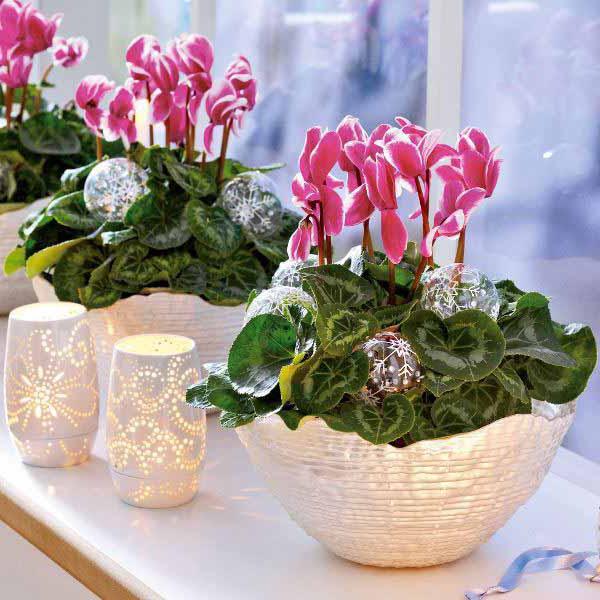

According to Feng Shui teachings, this plant helps to stabilize energy in a home or apartment, brings a sense of community and brings the family together. Frequent mood swings or depression, according to experts in this field, are also subject to him. The cyclamen will have a good effect on the work team and the atmosphere in it, therefore it will be a good choice for the office. If you want to bring vivid feelings into your life, give preference to a bright raspberry cyclamen; for romance, choose white or red.
What kind of soil to prepare?
If you buy ready-made soil, then no difficulties arise. If you want to cook it yourself, you need to take into account several important points. The homeland of indoor cyclamen determines its appearance, and this must be taken into account when choosing a soil. For Persian, experts advise preparing soil from leafy, soddy soil, humus and sand in equal proportions. The addition of crushed limestone or a small amount (1 part) of peat is very beneficial.
A slightly different ratio of the components of the composition requires the European cyclamen. The homeland of the plant is alpine meadows. Therefore, good drainage is imperative, and a mixture of turf, leafy soil, humus, peat and sand in a ratio of 2: 2: 2: 2: 1 is best suited for it. The soil mixture must be steamed or calcined in the oven to prevent the appearance of various pests and diseases. You can also add superphosphate (1 g), phosphate rock (4 g), ammonium nitrate (0.4 g) to 1 kg of finished soil. Cyclamen at home does not require a large pot, it is best to choose shallow ones, 10-15 cm in diameter.
Planting depth is of great importance.In the European cyclamen, the roots grow around the entire circumference of the tuber, so you can safely plant it completely in the ground. But for his Persian relative, it is best to leave the top above the soil surface.
It is not necessary to transplant the European cyclamen too often. If the pot is large, then it can rot or, at best, stop blooming. For large specimens, the pot is changed (1-2 cm larger than the previous one) once every 2-4 years.
Cyclamen (wild) tuber
Cyclamen forest, wild, collected in the forests of the Republic of Adygea. The flower is small - pink, lilac or purple, the aroma is light, pleasant. Tubers can be planted in the garden (cover for the winter with a layer of leaves), indoor pot. But it is mainly used to prepare drops of cyclamen for the treatment of sinusitis.
In the nodules of cyclamen, a miraculous power is hidden, which returns us to health and youth! It acts through the ability of our body to cleanse itself, helps to cleanse the sinuses of the huge amount of pus that accumulates in it. This condition is called sinusitis, and not only those who know about it, but also those who seem to breathe calmly through their nose, but ... snore at night suffer from it. It also affects those who have heart disease, asthma, chronic bronchitis.
How to prepare drops from cyclamen tubers?
Clean the tubers from leaves and fibrous roots, brush, wash thoroughly. Squeeze the juice through a juicer and dilute with cold bottled water 1: 4 (that is, you need to take 200 ml of water for 50 ml of juice). The finished drops have a very high concentration. If you are using cyclamen for the first time, you should dilute the oil 1:20 with eucalyptus hydrolate (or water at room temperature) - check the tolerance. If the burning is weak, you can increase the concentration, for example, 1:10. Thus, everyone feels for himself an individual concentration of the solution. With good tolerance, it is recommended to use drops of the initial concentration.
How to make cyclamen oil?
Cut the peeled, washed and dried tubers into small pieces, fill the container halfway, pour in a stable base oil (grape seed, olive). Insist 1 month in a dark, cool place. Strain, squeeze through a press. If you are using cyclamen for the first time or will drip to a child (from 5 years old), then you should dilute the oil 1: 5 with an infusion of eucalyptus (or any base vegetable oil, for example, olive oil) - check the tolerance. If the burn is weak, you can increase the concentration, for example, 1: 2. Thus, everyone feels for himself an individual concentration of the solution. If well tolerated, it is recommended to use the original concentration of oil.
How to use ready-made drops and cyclamen oil for the treatment of sinusitis, rhinitis?
Cyclamen drops are intended for the treatment of adults, oil is preferable for children.
It is necessary to drip drops / oil in the morning and in the evening, 2-3 drops into each nostril, massage the sinuses outside. Lie for 10 minutes, then drink a glass of hot infusion of herbs "Anti-infectious" or "With a cold, sinusitis" with honey and lemon juice. With the beginning of the application of the drops, the nose will be cleared by copious secretions. Additionally, wash the sinuses with an aqueous solution of dead sea salt. Use drops or oil for a course of 7 days, repeat after a 7-day break. With chronic sinusitis, adenoids, polyps in the nose, conduct 3 such courses. You can repeat the course in 2 months.
Contraindications: pregnancy, lactation, for oil, children up to 5 years old, for drops up to 7 years.
The plant is poisonous! Keep out of the reach of children! Do not put drops in your eyes! In case of contact with eyes, rinse thoroughly with warm water.
The shelf life of drops and cyclamen oil is 1 year. Store drops and oil in the refrigerator.
Storage of tubers: several days in the refrigerator, monitor their condition.
Planting cyclamen tubers in open ground
In the shade of shrubs or deciduous trees, in a mixture of sod and leafy soil with the addition of crushed limestone, crushed lime, good drainage is required. In central Russia, light shelter with leaves is needed for the winter; shelter is not required to the south. In autumn, the soil should be fertilized with good quality compost. With proper care and a good planting site, cyclamen will sow and produce new plants. You can place cyclamens on an alpine slide, only in the shade of stones or small bushes. They look good in large arrays among large stones and butt of old trees, other ephemeroids will make a pleasant company to them: crocuses, snowdrops, crocus flowers, as well as non-aggressive primroses.
Planting cyclamen tubers indoors in a pot
The tubers can also be planted in a commercial potting soil. The potting regime is basically the same for everyone. North and east windows are preferable, and on the south, plants need a shade. The soil is a mixture of leafy earth, sand and loam in a ratio of 2: 1: 1. The tuber is partially buried if the roots are located on its lower side, or completely if they cover the entire tuber, as in European and ivy-leaved cyclamens. Water regularly when the plants start to grow, add fertilizer during flowering, and almost stop watering when the leaves begin to wilt and the plant is about to dormancy. Only young specimens with small tubers that can dry out need rare watering and during dormancy. It is not recommended to pour water directly onto the tuber for them - this can cause rotting of the growing point, and then the whole plant. The flowering time of potted cyclamens depends on the conditions of detention (watering regime, lighting, temperature), but, in general, falls on the cold season - from autumn to spring.
ATTENTION! The size of the expelled tubers is inevitably different in weight and size, with a diameter of about 3-8 cm.
Water mode
The question of how to water cyclamen is very important. Compliance with the water regime is already half the success in the matter of cultivation. A plant at low temperatures (10-15 degrees) does not need high air humidity, it will feel comfortable enough anyway, so there is no need to spray. This is only required if the room is hot. But you need to spray not the plant itself, but the air around it, so that moisture does not get on the leaves or protruding tuber. Or you need to put the pot on wet gravel or expanded clay for a while.
The first thing to remember when growing cyclamen at home is that it absolutely does not tolerate excess moisture. Watering should be extremely careful, but abundant during flowering, the earthen coma should not be allowed to dry out. Water should not come into contact with the leaves or, moreover, the tubers, this can lead to decay of the roots. Therefore, you need to water near the very edge of the pot in which the flower grows. It is good to use melt water, if you take tap water, then before watering the cyclamen, you need to let it settle. This will take at least 12 hours.
Prophylaxis
Houseplants are difficult to cure. To prevent the flower from dying, it is advisable to prevent cyclamen diseases. Also, a lot depends on where you bought it. If from the hands, damage to the leaves, stems and flowers by aphids and thrips is possible. They never violate the recommended care conditions, since any deviation is fraught with the appearance of pests.
Inspect the plant every day... Do not miss a single leaf or flower while inspecting with a magnifying glass. If they find incomprehensible spots, they isolate him from others and begin to take measures to defeat the ailment. Sometimes even treatment with insecticides does not destroy the pest the first time. Isn't it easier to take preventive measures?
Attention! To prevent pests from appearing, the soil is sterilized and steamed before transplanting cyclamen. For preventive purposes, it is treated with a solution of potassium permanganate.
It should be faint and slightly pink in hue. Potassium permanganate is an effective means of combating bacterial and fungal infections. Do not often fertilize with nitrogen fertilizers, which reduce the immunity of cyclamen.
We suggest reading about other problems when growing cyclamen, in particular about what to do if it withers or dries up. And you can find out how to revive a plant that is dying for various reasons here.
Fertilizers
It is necessary to feed cyclamen at home during the active growing season, when intensive growth begins, buds are formed. You should not water the flower you just bought in the store with fertilizer, first let it acclimatize and get used to the new conditions. Frequency - once every two weeks. Fertilizers can be organic and mineral. With the latter, observe the measure and choose those in which the chlorine content is the lowest. Now in shops for floriculture you can find special fertilizers for each type of plant, they have selected the most optimal balance of mineral and organic substances, it is best to purchase just such. The concentration should not be determined by eye, proceed according to the instructions. Otherwise, this can lead to an excess of nitrogen in the soil, and this will lead to the fact that the leaves will develop more actively, simply put, the green mass will begin to build up, and you will not see the flowers.
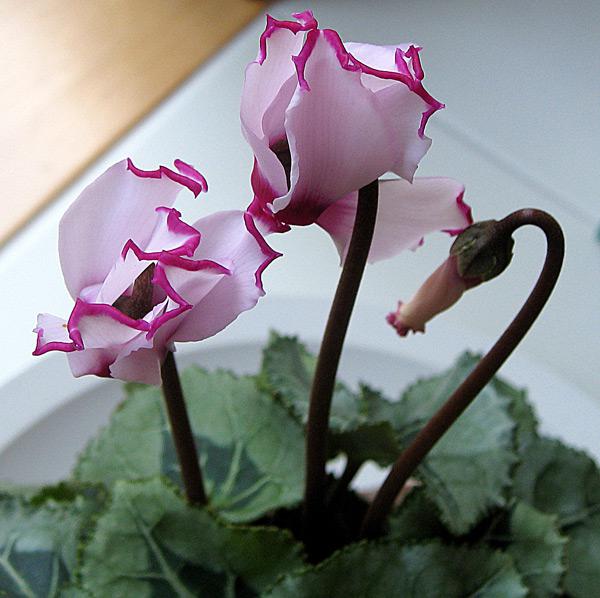

African
Cyclamen is divided into different types and subspecies (varieties), but one of the most common and popular types isAfrican.
The shrub thickets of Tunisia and Algeria are considered the homeland of the African duck. According to the botanical description, this type of plant is similar to the ivy-leaved cyclamen. There are two forms of African cyclamen: diploid and tetraploid.


The diploid form of the African duck has smaller leaves with different petiole shapes and more fragrant flowers. For decorative purposes, it is customary to use the diploid form of African cyclamen.
The leaves of this plant are heart-shaped. The color is silvery green. The leaves of the African duck grow directly from the tuber, reaching in length 15 cm.
This is one of the main differences between this plant species and ivy-leaved cyclamen. The plant blooms from spring to autumn, and young leaves begin to appear only in September-November.
The color of the flowers of African cyclamen varies from pale pink to deep pink.
Important! The duck contains substances that are toxic to the organisms of dogs and cats.
This type of plant is afraid of frosty winters, therefore it requires a special shelter. The flower also does not tolerate the hot sun (it is not for nothing that in North Africa it is found only in shrub thickets, where there is a lot of shade).
Plants that do not tolerate heat well: begonia, streptocarpus, heather, muraya, ampel petunia, indoor fern, cypress.
The African duck is characterized by very rapid growth and development in comparison with other representatives of the Mirsinov family. During the period when the plant sheds its leaves, it needs a cool (about 15 ° C) and dry place.
Cyclamen: how to care during flowering?
It is important to maintain the correct air temperature in the room, no more than 15 ° C, but not lower than 10 ° C - this is the key to abundant and long-term flowering. Cyclamen at this time needs abundant watering, but it cannot be poured. Therefore, excess water from the pan must be drained after 10-15 minutes. It is also necessary to monitor the leaves and remove dry ones in time, otherwise this can lead to the development of rot. When the peduncle withers, then it must be carefully removed. To do this, you need to turn it and pull it slightly.
Planting garden cyclamen
Garden cyclamens gradually grow, multiplying independently and forming colorful meadows. But this, of course, takes time.The easiest way to "quickly" increase the planting of alpine violets is to grow new plants from seeds. To do this, pour nutrient soil for seedlings into any container or pot, level it, sprinkle the seeds over it in a thin layer and cover the top with soil no thicker than 1 cm.Place the box or pot with seeds in such a room so that the ripening temperature is stable - about 18 ° C ... Water the seeds from a watering can with a spray. After the shoots appear, wait for the first pair of leaves to fully develop, and then dive each plant into a separate container.
Cyclamens grow both in the shade of shrubs and trees, and among large stones in rockeries. Also garden cyclamens can be used on classic rocky slides. Cyclamens look best when planted in large tracts, especially when combined with protruding roots of large trees and stones. From plants similar in form of growth, cyclamens can be planted with crocuses, snowdrops and crocuses; They also look good with species of primrose that are not prone to space capture. They go well with ivy, gentian and groundwort. All types of cyclamen can be grown as a pot culture.
To decorate the garden, you can use not only cyclamen growing in the open field, but also large-flowered "indoor" varieties of Persian Cyclamen, which love cold air. They can be set up in sheltered terraces and balconies at the end of summer and left there until the temperature drops to freezing.
Dormant period
As a rule, it occurs after 3-4 months of abundant flowering. And this is one of the answers to the question why the cyclamen withers. First, new buds cease to form, and then the leaves gradually wither and dry out. In the Persian cyclamen, this occurs in April, at which time it is necessary to reduce watering. And when there are no leaves at all, then you only need to slightly maintain the moisture in the soil. At this time, the flower pot must be removed to a cool and shaded place. In many countries, the Persian cyclamen is grown as a disposable plant, it is presented for Christmas or New Year, it happily pleases the owners with abundant flowering, and then it is simply thrown away. And this makes sense, because buying a blooming Persian cyclamen in a store, you are unlikely to achieve the same re-flowering at home. All of them are grown in greenhouse conditions and it is very, very difficult to get used to the indoor microclimate. Therefore, before buying, think about how to grow cyclamen, whether you have enough time for this, whether there is a suitable place in the apartment. If you decide, then be careful when choosing. It is necessary to give preference to those cyclamens that are just beginning to bloom, the soil should be moderately moist, the leaves - with normal turgor, roots and tubers - without rot and signs of insect damage.
After a period of rest, the Persian cyclamen returns to life at the beginning of winter. As soon as it is noticeable that leaves appear, you need to start watering and transfer the plant to a bright place.


European
Plant cyclamen european (blushing) is widespread in Central Europe (northern Italy, Slovenia, Macedonia).
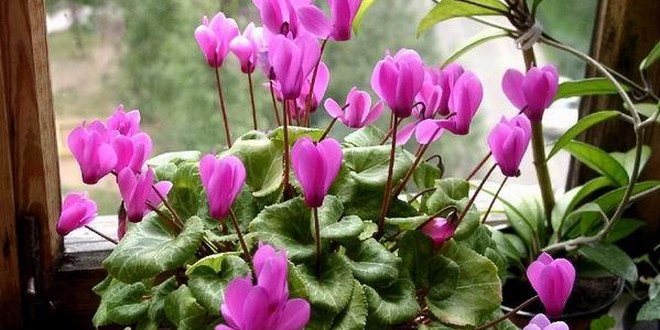

This is a herbaceous evergreen plant with a flat-round tuber (it is slightly flattened with a single growth point). With age, the tuber of the flower is deformed and gives thick shoots, which have their own points of growth.
The leaves of this species are basal with a silvery-green color. They are heart-shaped with a pointed tip and a slightly serrated edge.
The underside of the leaves is purple-green. Flowers are five-petal, single, with very long peduncles. The petals are oval and slightly twisted into a spiral. The peculiarity of the European duck is its sharp and delicate aroma.
Did you know? One of the varieties of the European duck - purpurascens, is distinguished by very beautiful crimson or violet-pink flowers. Translated from Latin, the word "purpurascens" means "turn purple."
Flowering continues throughout the growing season - from spring to autumn... The color of the flowers is different: light purple, pale pink, bright purple, pink-purple.


Breeders have bred several forms of European cyclamen, which differ in the flowering period and color of the flowers.
The following varieties are popular with many gardeners: purpurascens (purple-pink flowers), carmineolineatum (white flowers), lake garda (pink flowers), album (white flowers).
Reproduction of cyclamen
This can be done in two ways: from seeds and by dividing the tuber. The latter method is very traumatic for the plant, which leads to its low efficiency and therefore it is practically not used at home. Growing cyclamen from seeds is a more suitable breeding method, and for the Persian varieties it is the only acceptable one. If several varieties grow in your home, and you want to get copies that are identical to them, then it is better to abandon this idea. Home-grown seeds are unlikely to retain the phenotypic properties of their parents. This is due to the fact that all store plants are hybrids in the first generation, their further reproduction leads to the splitting of traits. Therefore, the seeds must be bought, and preferably from a reliable producer.
Planting cyclamen with seeds is possible all year round, but it is best to do this in early spring. Use a commercially available, ready-made, sterile primer. The seeds must first be soaked in a solution of any growth biostimulator, for example, the drug "Epin", as written in the instructions for use. The box is not needed very deep. Make grooves (1 cm) in the ground, water them gently from a watering can and spread the prepared seeds. Then you need to close the container with opaque polyethylene, since darkening is necessary for germination. Do not forget to maintain moisture in the soil and a sufficiently high air temperature - 20 ° C. After a month or a month and a half, shoots appear, you need to remove the film and rearrange the box in a place with a bright diffused light. When a young plant has two or three true leaves, it must be dived into a separate pot, and after 6-7 months transplanted into a larger container with a diameter of 8-10 cm. It is noteworthy that in the first year the cyclamen does not "rest", but blooms in about 2 years. Growing cyclamen at home from seeds is quite troublesome and requires a careful and attentive approach.
Cyclamen forest
Cyclamen forest is a wonderful wild plant. It has very unusual flowers, original in shape, with a unique smell. The leaves of this plant species are most often green, sometimes with an ash pattern with a wavy or jagged edge.
Forest species of cyclamen can be found in many parts of the world. The growing conditions of forest cyclamens are very different from each other. Some types of cyclamen in nature grow among the rocks, others in the forest, some on the slopes of the mountains. Plants have learned to adapt to their environment. So, flowers growing in impenetrable spruce forests, where the crown of trees poorly transmits sunlight, are used to being content with twilight and are not demanding on good lighting. Cyclamens growing among rocks, where there is little fertile soil, receive some of the nutrients from the tuber, and moisture from the air. Especially difficult conditions for the survival of flowers growing on forest slopes. The land is loose, in spring and during a particularly humid period, after rains, landslides occur. In this situation, it often happens that the root of the forest cyclamen is at a depth of 15 cm. In this case, the plant grows a stem of the required length, which carries the bud to the surface of the earth.The height of flowering cyclamens is usually about 10 cm. In some species, flowers appear before leaves, most often they are plants blooming in autumn. In other, spring and summer species, leaves and flowers appear together.
A few decades ago, flowers of forest cyclamens could be picked near cities. These plants grew everywhere and were considered to be quite common forest flowers. Every spring in the markets, flower girls sold small bouquets of raspberry and lilac wild cyclamens, which filled the air around them with a heady aroma. Forest cyclamens were dug up, brought home and grown in their gardens.
In the future, through complex selection, experienced florists bred new, more hardy and unique varieties. Cyclamen tubers were used by healers for the preparation of their medicines. Currently, their populations have decreased several times, many species are now on the verge of extinction. But, to this day, this flowering herb can be found in protected, little-visited by people, inaccessible areas. Of course, when you suddenly meet somewhere in the forest or on rocks among the stones an island of forest cyclamens, your heart skips with delight and then you remember these amazing flowers for a long time.
Until now, the wild form of cyclamen can be found in Central Europe, Iran, the countries of the Mediterranean and Asia Minor. In our country, forest cyclamens such as the Colchis cyclamen and Kuznetsov's cyclamen grow in the forests. Now also endangered plant species and they are included in the Red Book. The halo of their habitat is very narrow. So, the Colchis cyclamen is common in the south of the Western Caucasus, and Kuznetsov's cyclamen only in some regions of the Crimea. Colchis cyclamen grows in subalpine forests on limestone rocks. It blooms from August to October. It has heart-shaped leaves that are dark green on top and reddish on the back. The flowers of this species are pink with a burgundy spot at the base of the petal, with a scent reminiscent of lily of the valley. Cyclamen Kuznetsova prefers beech, oak, hornbeam and ash forests with fertile soils. Its leaves are oval, green with gray spots on the upper side and purple on the bottom. It blooms in spring in March - February with pink or white flowers, bent back. They have a lilac spot at the base and have a strong scent.
Forest cyclamens are very different in appearance from the large, bright flowers of cyclamens grown at home. Wild species of cyclamen have smaller and paler flowers than those of ornamental plants. Sometimes, their nondescript flowers are so different from their room brothers that their relationship can only be determined by a slightly similar shape. But still, forest cyclamens are, although modest, but rather gentle and cute creatures. The most important virtue of these wild plants is the honey aroma that almost all of them possess. True, some of their relatives of indoor species, when flowering, exude a pleasant aroma, but it is usually very weak.
Forest cyclamens are huge and miniature, it depends on the favorable climate of their habitat.
The largest among the wild species of cyclamen is the African cyclamen (Cyclamen africanum). The homeland of this flower is Algeria and Tunisia. It grows in rocky areas, among thickets of bushes. This plant has leaves up to 15 cm long and up to 10 cm wide in diameter. The root of this cyclamen grows very quickly and reaches a large size. The flowers of the African cyclamen appear on the bare tuber. This happens in the month of September. The blossoming flowers range in color from light pink to dark pink. They are quite large up to 8 cm and are located on a long, strong peduncle. Plant height reaches 22 cm. Bright green leathery leaves appear after flowers. After the end of flowering, the leaves of the plant also die off, a period of complete dormancy begins.
Small-flowered cyclamen (Cyclamen parviflorym) has a wide habitat. This flower can be found in the rocky gorges of northern Turkey and in the spruce forests of central Russia among mosses and lichens. The usual conditions for the growth and development of a plant of this species are fertile, humus-rich leafy soil, high humidity and dusk under the crowns of age-old trees. The leaves of the small-flowered cyclamen are not at all large, rounded, matte with diameters from 15 to 30 mm. They are located on short cuttings and are dark green in color. The flowers of this type of cyclamen are small, petals are 4 to 10 mm in length. The range of flower shades is wide - from pale lilac and pink to deep pink. Each petal of a small-flowered cyclamen has a burgundy spot at the base.
Forest cyclamens are unique flowers that are less and less common in our forests. And it depends on each of us whether our descendants will see them. If, wandering through the forest, you accidentally stumble upon these fantastic flowers, stop, admire them and leave them to grow in their native place!
Primrose in the garden
Cyclamen is most popular as a houseplant and has been completely forgotten as a garden flower. It is possible to grow it in the open field, but still it should be done in warmer regions of Russia, with mild winters and long summers. Best of all, of course, the European cyclamen is suitable for these purposes. It will look great in rock gardens, in group plantings with crocuses and other primroses. Some professional gardeners manage to grow it even in the Urals. If you want to decorate your site with cyclamens, then it is worth remembering a few basic nuances:
- the planting site must be protected from drafts and rain, for example, under garden trees;
- the soil should be well-drained, allow moisture to pass through, avoiding stagnant water;
- if there is little snow in winter, then you should slightly cover the cyclamen with spruce branches;
- the tuber must be planted completely in the ground, without leaving the upper part above the surface;
- do not change the place of the plant on the site too often, as this will weaken it, the cyclamen can grow for a long time without planting.
Cyclamen tubers
Forest cyclamen, wild, collected in the forests of the Republic of Adygea. The flower is small - pink, lilac or purple, the aroma is light, pleasant. Tubers can be planted in the garden (cover for the winter with a layer of leaves), indoor pot. But it is mainly used to prepare drops of cyclamen for the treatment of sinusitis.
In the nodules of cyclamen, a miraculous power is hidden, which returns us to health and youth! It acts through the ability of our body to cleanse itself, helps to cleanse the sinuses of the huge amount of pus that accumulates in it. This condition is called sinusitis, and not only those who know about it, but also those who seem to breathe calmly through their nose, but ... snore at night suffer from it. It also affects those who have heart disease, asthma, chronic bronchitis.
How to prepare drops from cyclamen tubers?
Tubers are cleaned of leaves and fibrous roots, cleaned with a brush, and washed thoroughly. Squeeze the juice through a juicer and dilute with cold bottled water 1: 4 (that is, you need to take 200 ml of water for 50 ml of juice). The finished drops have a very high concentration. If you are using cyclamen for the first time, then you should dilute the oil 1:20 with eucalyptus hydrolate (or water at room temperature) - check the tolerance. If the burning is weak, you can increase the concentration, for example, 1:10. Thus, everyone feels for himself an individual concentration of the solution. With good tolerance, it is recommended to use drops of the initial concentration.
How to make cyclamen oil?
Cut the peeled, washed and dried tubers into small pieces, fill the container halfway, pour in a stable base oil (grape seed, olive). Insist 1 month in a dark, cool place.Strain, squeeze through a press. If you are using cyclamen for the first time or will drip to a child (from 5 years old), then you should dilute the oil 1: 5 with an infusion of eucalyptus (or any base vegetable oil, for example, olive oil) - check the tolerance. If the burn is weak, you can increase the concentration, for example, 1: 2. Thus, everyone feels for himself an individual concentration of the solution. If well tolerated, it is recommended to use the original concentration of oil.
How to use ready-made drops and cyclamen oil for the treatment of sinusitis, rhinitis?
Cyclamen drops are intended for the treatment of adults, oil is preferable for children.
It is necessary to drip drops / oil in the morning and in the evening, 2-3 drops into each nostril, massage the sinuses outside. Lie for 10 minutes, then drink a glass of hot infusion of herbal preparations No. 52 "Anti-infectious" or No. 47 "With a cold, sinusitis" with honey and lemon juice. With the beginning of the application of the drops, the nose will be cleared by copious secretions. Additionally, wash the sinuses with an aqueous solution of dead sea salt. Use drops or oil for a course of 7 days, repeat after a 7-day break. With chronic sinusitis, adenoids, polyps in the nose, conduct 3 such courses. You can repeat the course in 2 months.
Contraindications: pregnancy, lactation, for oil, children up to 5 years old, for drops up to 7 years.
The plant is poisonous! Keep out of the reach of children! Do not put drops in your eyes! In case of contact with eyes, rinse thoroughly with warm water.
The shelf life of drops and cyclamen oil is 1 year. Store drops and oil in the refrigerator.
Storage of tubers: several days in the refrigerator, monitor their condition.
Planting cyclamen tubers in open ground
In the shade of shrubs or deciduous trees, in a mixture of sod and leafy soil with the addition of crushed limestone, crushed lime, good drainage is required. In central Russia, light shelter with leaves is needed for the winter; shelter is not required to the south. In autumn, the soil should be fertilized with good quality compost. With proper care and a good planting site, cyclamen will sow and produce new plants. You can place cyclamens on an alpine slide, only in the shade of stones or small bushes. They look good in large arrays among large stones and butt of old trees, other ephemeroids will make a pleasant company to them: crocuses, snowdrops, crocus flowers, as well as non-aggressive primroses.
Planting cyclamen tubers indoors in a pot
The tubers can also be potted using commercially available universal potting soil. The potting regime is basically the same for everyone. North and east windows are preferable, and on the south, plants need a shade. The soil is a mixture of leafy earth, sand and loam in a ratio of 2: 1: 1. The tuber is partially buried if the roots are located on its lower side, or completely if they cover the entire tuber, as in European and ivy-leaved cyclamens. Water regularly when the plants begin to grow, add fertilizer during flowering, and almost stop watering when the leaves begin to wilt and the plant is about to dormancy. Only young specimens with small tubers that can dry out need rare watering and during dormancy. It is not recommended to pour water directly onto the tuber for them - this can cause rotting of the growing point, and then the whole plant. The flowering time of potted cyclamens depends on the conditions of detention (watering regime, lighting, temperature), but, in general, falls on the cold season - from autumn to spring.
ATTENTION! The size of the expelled tubers is inevitably different in weight and size, with a diameter of about 3-8 cm.
adenoids nasal polyps, tonsillitis, coryza, sinusitis
Diseases and pests
Most often, the defeat of a plant by bacterial or fungal diseases is facilitated by improper care, namely:
- too dry air, excess moisture in the soil, improper lighting - all this weakens the immune system;
- improperly selected substrate;
- too large or, conversely, a small pot;
- excess fertilizers containing nitrogen;
- wrong location in the apartment.
Consider the most common diseases that cyclamen is prone to at home.
- Fusarium. It has a fungal nature and primarily affects the vessels of the plant. Therefore, the grower should be alert when the leaves begin to turn yellow from the top and gradually wither. You can save the plant by spraying and watering under the root with solutions of special fungicidal preparations.
- Gray rot. Its cause is the Botrytis fungus. Development is facilitated by high humidity and cold air, as well as the ingress of water into the outlet of leaves and buds during watering. Cyclamen, the photo of which is presented below, is affected by the Botrytis fungus. When similar signs of disease are found, the first thing to do is to isolate the infected plant from healthy specimens. The second step is to remove and destroy the damaged parts, and then treat the cyclamen with a fungicide.
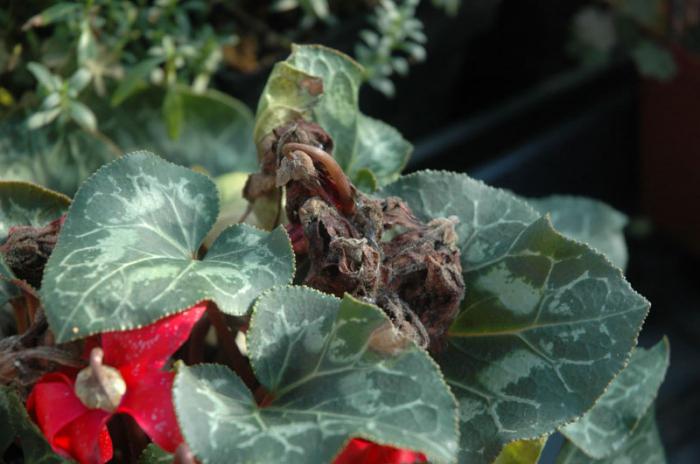

- Anthracnose. This fungal disease, on the other hand, occurs in warm climates and excess moisture in the soil. It affects first the leaves and peduncles, and then the entire cyclamen. The photo clearly demonstrates that when damaged buds bloom, they lose all decorativeness, and the leaves dry out.
- Of the pests, aphids, thrips and cyclamen ticks should be noted. If the first two pests can be seen upon close examination, then the last one cannot. The cyclamen mite is very small, you can understand that the plant is infected with it by several signs: the affected growth point, the petiole of the central leaves becomes curved and does not grow, remaining short, the buds do not bloom and dry out. An infected flower needs insecticide treatment. Thrips can be easily spotted with the naked eye. The plant is damaged by adult insects and their larvae. They are mainly dangerous for leaves and buds, in the process of life they leave noticeable "paths". High room temperature and dry air contribute to the spread of thrips.
In the fight against pests and diseases of a fungal or bacterial nature, special preparations will undoubtedly help: Oxyhom, Fundazol, Fitosporin, Topaz, Agat-25K, colloidal sulfur.
And remember that the spread of disease can be avoided by observing the correct irrigation system and promoting the circulation of air in the room, preventing it from stagnating.
Prevention of flower diseases
To avoid unpleasant situations with the appearance of pests on a flower, follow these rules:
- Examine existing and newly acquired plants carefully for pests.
- Buy only healthy and high-quality planting material from trusted suppliers in specialized stores.
- Isolate damaged flowers from healthy plants.
- Disinfect dishes and soil before planting and transplanting a flower.
- Significantly increase the resistance of cyclamens to pests regular and correct watering, airing the room, competent feeding and lighting regime.
In order for your plant to please for a long time with its healthy and flowering appearance, it is very important to know about all the rules for caring for it. We have prepared for you materials on eliminating such problems with cyclamen: the plant dies, the flower stalks dry out, the flower is flooded, the leaves wither and dry.
Reproduction
Using seeds
Cyclamen seeds can be purchased at the appropriate store, or you can get it yourself by pollination.
Pollination
Better if it is cross, between two plants. If there is one specimen, pollinate between 2 flowers.
Pollination conditions:
- in the morning of a sunny day;
- a soft object (for example, a paintbrush);
- repeating the procedure several times (for reliability).
Before or immediately after pollination, the plant is maintained with potash and phosphorus fertilizers.For example, taking 1 g of superphosphate and 0.5 g of potassium sulfate, dissolved in a liter of water.
After ripening, the seeds are harvested, but not dried, this reduces their germination.
Selection and preparation of seed
The seeds are placed in a container filled with a 5% sugar solution. Those that have sunk to the bottom, suitable for sowing, will sink to the bottom. The selected seeds are soaked for a day in a solution of Zircon.
Sowing
Carried out in August, in moist soil, composed of leafy earth and peat (vermiculite), in a ratio of 1: 1. Seeds are spread over its surface and sprinkled with earth per centimeter.
Good germination conditions:
- observance of the temperature regime: at temperatures above 20 ° C the seeds "fall asleep", below 18 ° C - they rot;
- darkness: the container with crops is covered with an opaque film;
- periodic ventilation and soil moistening.
Seedlings should appear in a month. As soon as this happens, the container is transferred to a bright and cooler (15-17 ° C) room.
Growing seedlings
Picking
It is carried out after the appearance of a second leaf in plants and the formation of a small nodule. This usually happens in December. The pick is carried out into the soil of the same composition as for crops. Cyclamen nodules are completely covered with earth.
Seedling care
A week after the manipulation, seedlings are fed using any diluted flower fertilizer. For example, a 0.2% solution of ammonium sulfate is added, after 10 days - 0.1% potassium nitrate.
At the end of April, in the first half of May, young Cyclamens are moved to a permanent place in pots. They will bloom in a year and a half.
How and how to treat correctly?
Cyclamen treatment should be carried out in a comprehensive manner. Before you save a flower, you should definitely determine what reason led to its damage. At the same time, it is extremely important to identify diseases caused by pests. If, however, changes in the indoor microclimate have led to damage to the plant, in this case it is necessary to adjust the humidity and temperature, as well as the frequency of watering. Unfortunately, it is not always possible to revive almost completely dried cyclamens. This usually happens if treatment was not started on time. In case of severe damage to the cyclamen root apparatus, unfortunately, you will have to say goodbye to it.
Treatment of diseases caused by pests consists in the use of special preparations. So, in order to cure a diseased plant from aphids, it should be treated with an insecticidal agent, for example, "Aktara" or "Commander". It is necessary to process leaves affected by pests. It is more convenient to do this with a cotton swab dipped in a medicinal product.
After an insecticide has been applied to a flower affected by aphids, it must be rinsed under the shower.
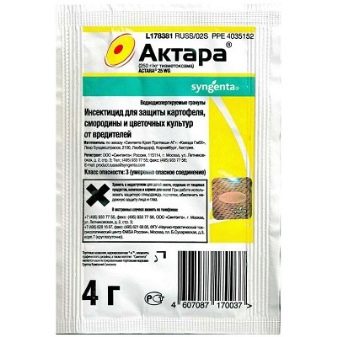

It is also necessary to do insecticidal treatment if the plant is affected by thrips. For this, drugs such as "Apache", "Akarin" and others are used. Before spraying the affected flower, the insecticidal agent must be diluted with water. This must be done according to the instructions. It will be possible to revive the plant only if, in addition to insecticidal treatment, the humidity in the room is adjusted. So, if the air in the room is too dry, in such a situation it is recommended to think about purchasing a humidifier or placing a container with water at a short distance from the plant.
Insecticides are also necessary for the treatment of cyclamens from scabbards. Dealing with them can be quite tricky. In some cases, several re-treatments of the damaged plant against these pests are required. Usually, the flower should be treated at intervals of 2-4 weeks (depending on the chosen insecticidal agent).
During therapy, the sick cyclamen must be quarantined.
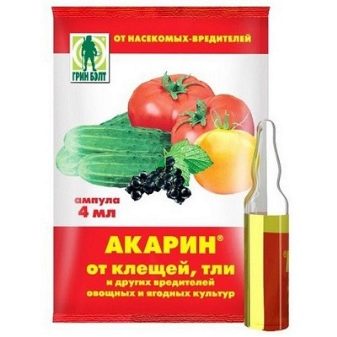

Resuscitation of a plant infected with gray rot is carried out in a complex manner. If characteristic signs of this pathological condition appear, the flower should be cut off immediately. In this case, you need to remove all damaged areas. To improve the condition, the cyclamen should be moved to a room that is well ventilated, and any drafts should be excluded. An important part of the treatment for gray rot is to reduce the frequency of watering. The accumulation of excess moisture in the soil will only contribute to the progression of the disease.
After cutting off damaged leaves, the plant must be treated with insecticidal preparations.
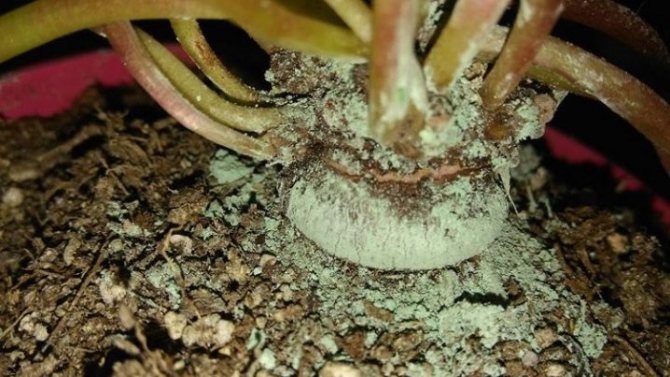

Persian varieties
Most often on our windowsills you can find Persian cyclamen. Currently, breeders have bred a wide variety of varieties of this plant, distinguished by incredibly beautiful flowers. Despite the fact that the life of one flower lasts only ten days, the total duration of flowering is six months due to the fact that up to a hundred flowers bloom on one tuber during the entire flowering period. This period lasts from October to March.


The most famous varieties of Persian cyclamen with white flowers are:
- Cyclamen is white with an eye. Differs in large, fringed double inflorescences of white color with a pink eye at the base. Outwardly, they resemble beautiful butterflies that adorn the room from late autumn to late April.
- Cyclamen "White Angel". It has the same lush terry flowers with fringes, but completely white, without a single spot. It blooms very profusely. A flowering bush of this species outwardly really resembles angel wings.
- "Victoria". Another variety with large double flowers. White buds with lush crimson fringes around the edges leave an unforgettable impression.
- "Charlie". A variety with snow-white flowers without fringes. Has a more strict and laconic look than previous plants. Peduncles do not exceed twenty centimeters in length. It blooms during the entire autumn-winter period, delighting not only with its appearance, but also with a strong refined aroma.
All cyclamens, regardless of the type, require increased attention and proper care. Consider the basic requirements for plant maintenance.
Cyclamen care
During the flowering period (in the European - all summer, and in the Persian - March in the middle lane, if the plant is cultivated in open ground), the cyclamen needs watering. Water evenly, trying to prevent both overdrying and stagnation of water in the soil. Water it carefully, avoiding the ingress of water into the rosette of leaves, this can lead to rotting of the plant.
Cyclamen care also consists in the timely removal of its wilted flowers, as well as yellowed leaves of the plant. Moreover, if the withered flowers can be simply cut off or torn off, then the dried leaves must be carefully "unscrewed", avoiding damage to the growth zone of the plant.
As for the dressing, we feed the cyclamen for the first time only a month after planting, using ready-made liquid fertilizer mixtures for this. The second time - a month after the first.
For the winter, the cyclamen must be well covered, otherwise it can freeze out, for this we use ordinary foliage, a 5-cm layer of which will help to preserve the moisture necessary for the plant, prevent it from freezing, and also provide fertile organic matter.
varieties ❀ planting ❀ care


In March, after the snow melts, lilac and pink fluttering butterflies appear in the gardens on flower beds - these are flowering cyclamens. And if at the beginning and in the middle of the gardening season they simply merge into the general chorus of the first gentle colors, then in the fall they seem to be a real outlandish miracle. Winter-hardy and so similar to the legendary indoor flowers, these plants in gardens will happily settle in a secluded shade under the crowns of tall shrubs and trees, as if emitting a pink shimmer.Against the background of fallen fiery leaves covering the soil, tiny flowers with petals turned upwards on a thin peduncle seem to be an unusual mirage.
Read also Spruce prickly gray photo and description
| ARTICLE IN THE TOPIC: Forcing bulb flowers at home |
Cyclamen or dryak belongs to the primroses family. These are perennial tuberous, with kidney-shaped, ovoid leaves with a heart-shaped base. The flowers of the plant are solitary purple, pink with a dark eye. The fruit of the cyclamen is a spherical capsule. Small-flowered garden cyclamens in structure and appearance do not differ in anything except size from large-flowered indoor pets.
Having decided to plant a cyclamen in your area, remember that, like most exotic plants, it is poisonous! In fairness, it should be said that its poison is practically harmless to humans (well, of course, if you are not going to eat it) and is a real danger only for animals, although not for everyone. So, for example, pigs eat juicy cyclamen tubers with great pleasure, especially fashionable Vietnamese pigs love this exotic food, and the plant does not harm them. For this amazing feature, cyclamen is called "pork bread". Cyclamen can harm rabbits, chickens, etc ... But this does not mean at all that cyclamen should not grow in the garden, just try to plant it out of the reach of agricultural animals.
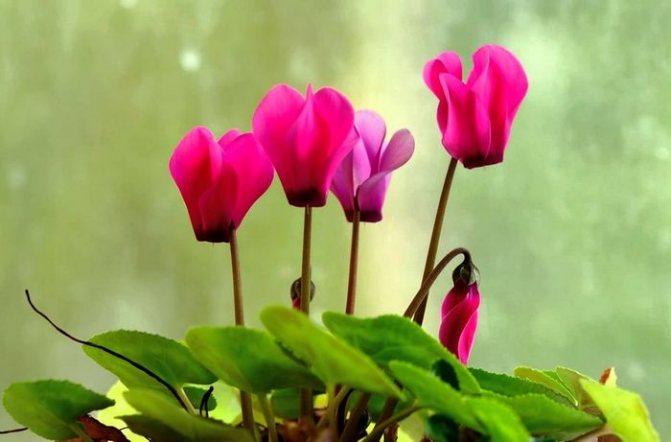

Types and varieties of cyclamen
The genus cyclamen, according to some sources, has 20 species, and according to others - as many as 55, where it is true, I could not figure it out. I only know that these extraordinary plants are widespread mainly on the shores of the Caspian, Black and Mediterranean seas. True, in Central Russia, cyclamens from the Crimea, the Caucasus and Central Europe are mainly grown. Most often, European cyclamen is grown in open ground, less often Persian.
Cyclamen Persian
Persian cyclamen, whose homeland is Iran and the Mediterranean countries, is a perennial tuber-root herbaceous plant, reaching a height of 30 cm. Its basal leathery leaves are dark green in color. There is only one growth point on the tuber of Persian cyclamen, damage to which will lead to the death of the plant. The flowers of Persian cyclamen are different in color: white, pink, crimson, purple, purple and even burgundy. Some varieties of Persian cyclamen are distinguished by a sharp and even slightly intrusive, but very pleasant smell. Flowers, as I said, can be pink, crimson, white, lilac.
Cyclamen european
Cyclamen European, or, as it is also called, ivy-leaved, whose homeland is the Crimea and the countries of Southern Europe, is a small herbaceous evergreen tuberous plant. Its leaves are round-kidney-shaped and have a heart-shaped base. The tuber of European cyclamen, on the entire surface of which there are small roots, more spherical and slightly elongated, can reach up to 10 cm in diameter. The flowers of European cyclamen are relatively small, have a strong pleasant aroma and a delicate lilac-pinkish color.
My story about cyclamen has come to an end, and I will be very glad if it is useful to you. Do cyclamens grow in your garden?
Cyclamen growing from seeds
Cyclamen seeds are sown in February in containers filled with a moistened universal substrate. Thoroughly sprinkle them with earth, with a layer of about 1 cm. Crops are regularly watered, preventing the soil from drying out. The optimum temperature for germination of cyclamen seeds is + 18 ° C.
Seedlings appear about a month after sowing. Seedlings of cyclamen dive, when they have two leaves, in small pots with a diameter of 5-6 cm, leaving the nodules not covered by 1/3. They are planted in a permanent place by the end of May. Plants will bloom only for 2 years, when their tuber gains the required mass.
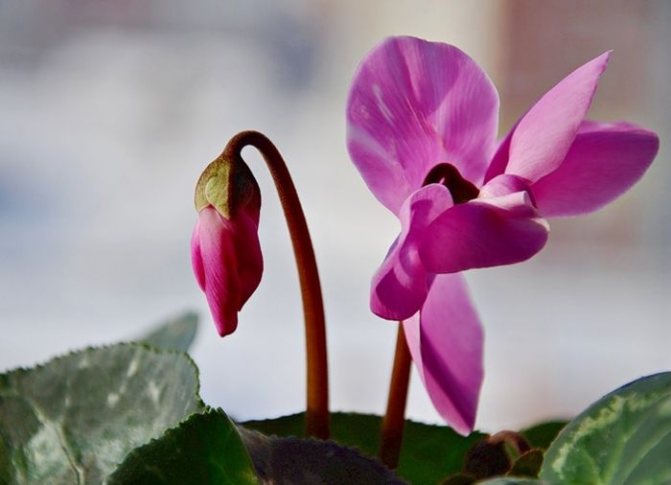

General information about the plant
Flower names
The name of the plant is of Greek origin. Kuklos means circle or cycle. There are several assumptions regarding its occurrence:
- round tuber shape;
- the ability of the corolla to twist into a round spiral after flowering;
- the cyclical development of the plant: ascended, released leaves, blossomed, left seeds and again to rest, until the next season, in which everything will repeat in a circle.
For a long time, there have been other names:
- the ancient Greeks, noting the unusual rhythm of Cyclamen's life, named him "Sleeping in summer".
- Alpine violets - this is how Cyclamens growing in the mountains of Central Europe are still called.
The keen eye of the people awarded this plant with many other, not so romantic and euphonious names based on the benefits of the plant:
- "Earthy apple" or "earthy radish" indicate the round shape of its root.
- For the ability to relieve disease - Bogoroditsin grass.
- The medicinal properties of Cyclamens are also noted in the names "Georgian dryakva" or "Dryakhva-grass". The origin of the words "Dvyakva" or "Dryakhva" has not been established, but "Georgian" is quite understandable: for the first time records about the healing properties of Cyclamen tubers were found in Georgia, and they are dated 3-4 century BC. e.
- "Gdula winter" - for blooming in winter.
- The name "Pig Potato" reflects the food sympathy of pigs for the (poisonous!) Cyclamen tubers.
Today Cyclamen is used exclusively for decorative purposes. Most often it is grown indoors. Cyclamen flowers are sometimes used for cutting. They last up to 2 weeks.
Homeland
Wild Cyclamens are found in the central part of Europe, the Mediterranean countries, on the lands of Asia Minor and Iran, in the northeast of the African continent.


On the territory of Russia, a strand of 10 types of Cyclamens grows (Crimea and the Caucasus)
Useful properties of cyclamen
Like any poison, in small doses it has healing properties.
Cyclamen normalizes the functioning of the genitals, in particular the menstrual cycle, treats infertility. It normalizes the work of the heart rate, restores the immune system, it is recommended to take drugs based on it for diabetes, allergies, gout, migraines.
From the root, an infusion is made for rheumatism and neutralization of poison when bitten by a snake.
Preparation of infusion
- 1 tbsp. l. chopped tubers pour 250 ml of boiling water
- Cover tightly and let it brew for 4-5 hours
- Then filter and drink 50 grams in the morning and evening.
Preparation of alcoholic tincture
- For 10 ml of alcohol, 1 gram of crushed raw materials.
- Close tightly and leave for 1 week.
- Take 30 drops 3 times a day, diluted in a glass of water.
- It helps well with menstrual irregularities, neuralgia, indigestion, colic, rheumatism.
The use of cyclamen is allowed under supervision and with the permission of a doctor.
List of species
According to database information The plant list
, the genus includes 20 species [5]:
- Cyclamen africanum Boiss. & Reut.
- Cyclamen alpinum Dammann ex Spreng.
- Cyclamen balearicum Willk.
- Cyclamen cilicium Boiss. & Heldr.
- Cyclamen colchicum (Albov) Correvon
- Cyclamen coum Mill. - Dryak koskaya
- Cyclamen creticum (Dörfl.) Hildebr.
- Cyclamen cyprium Kotschy - Cypriot cyclamen
- Cyclamen graecum Link
- Cyclamen hederifolium Aiton
- Cyclamen intaminatum (Meikle) Gray-Wilson
- Cyclamen libanoticum Hildebr.
- Cyclamen mirabile Hildebr.
- Cyclamen parviflorum Pobed.
- Cyclamen persicum Mill. - Persian cyclamen
- Cyclamen pseudibericum Hildebr.
- Cyclamen purpurascens Mill.
- Cyclamen repandum Sm.
- Cyclamen rohlfsianum Asch.
- Cyclamen somalense Thulin & Warfa
Distribution map of species of the genus cyclamen in Europe, Asia and Africa. (Estimated distribution according to wikipedia sources and information from "cyclamen.org"))
What insects like to feast on cyclamen?
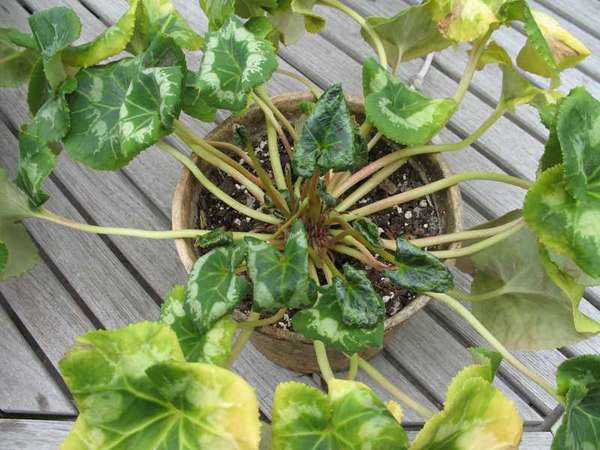

Another problem when growing cyclamen is pests. The succulent leaves of cyclamen attract the attention of not only flower growers, but also various insects. Having established who exactly attacked your flower, you can help it get rid of the "intruders". This can be done with a magnifying glass or by the nature of the changes occurring with the bush.
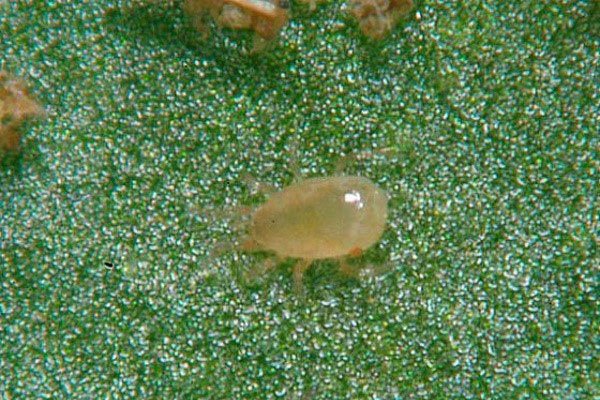

The appearance of a cyclamen tick is easy to notice by the following signs:
- at first, the leaf plates begin to lose their shape and bend ugly;
- then they stop growing and become tough;
- inflorescences wither, and peduncles are deformed (bent).
Unfortunately, most often it is not possible to get rid of the insect, since ordinary insecticides and fungicides do not have the desired effect on it. It remains only to voluntarily "kill" the plant in order to avoid contamination of all the flower collection.
If thrips appear on the cyclamen, the leaves of the plant:
- first covered with white dots;
- then they merge into gray-silvery spots;
- begin to curl;
- gradually die off.
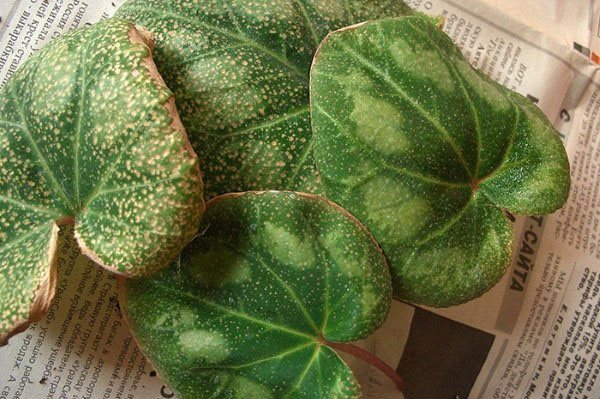

In the fight against thrips, Aktara or Fitoverm are used. At the initial stage, when there are still not very many pests, drugs can help get rid of them. With a massive defeat, the flower dies.
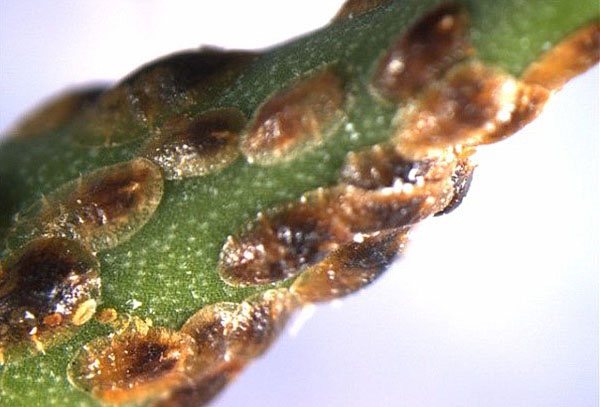

One of the most dangerous pests of cyclamen is the scabbard, primarily for the reason that it is generally impossible to get rid of it with the help of drugs. Often, growers do not even notice it until the flower begins to disappear. If you see bulging growths on the petioles, peduncles or the back of the leaves, this is not a deformation of the plant, but a very dangerous enemy. The scale is covered from above with a strong semicircular shell that protects it. The insect is firmly attached to the flower, literally merging with it into one whole, and no chemicals will help here. You can get rid of the scabbard on the cyclamen only mechanically, manually tearing it off.
To facilitate the process, before removing the pest, it must be wiped with a swab dipped in alcohol. During the removal, the soil under the bush should be covered so that the scabbard does not fall into the pot.
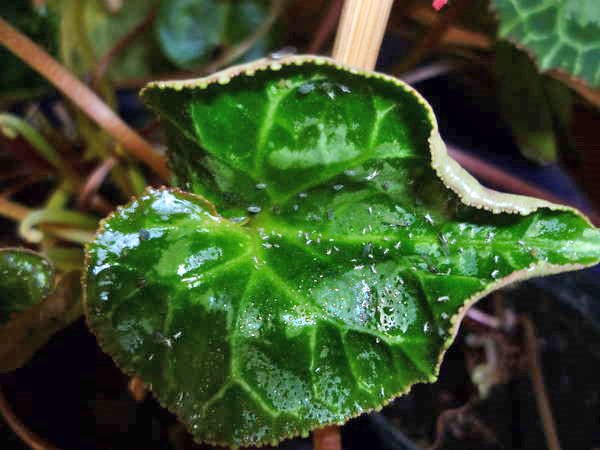

Frequent "guest" on cyclamen and aphids. These small white insects suck the juices from the leaves, as a result of which they begin to curl and deform, becoming covered with a sticky bloom, and young leaves appear small and also curved.
You can free cyclamen from aphids by regularly washing the leaf plates with a solution of green or laundry soap, additionally spraying the bush with Fitoverm.
Application
In folk medicine, from the time of Hippocrates to our days, many diseases are treated with cyclamens. The earliest doctors used cyclamen for rheumatism, sinusitis, and poisonous snake bites. It is used in homeopathy (for diseases of the central nervous system, female genital organs, nose, eyes).
In ancient Rome, cyclamens were planted along with daffodils and violets in the plots and in the house.
In one of the books of the 18th century, cyclamen is called pork bread. "Pigs, tearing the ground with their snouts, deliberately look for the roots of this plant, and willingly feed on them, which is why it was named pork bread" [source not specified 3456 days
].
Pests
Various parasites can also damage the flower. One of the pests that lead to plant damage are scale insects. The plant can be affected by both adults and larvae. With severe damage to the plant, pests can be found almost everywhere - on leaves, soil substrate, peduncles, flowers. The danger of adults for plants also lies in the fact that they are able to infect several flowers at once, since they have wings and can fly from place to place. Moreover, small parasites can fly even to a neighboring flower. That is why experts recommend isolating a plant infected with scale insects from others.
Thrips can also harm cyclamens. The adult representatives of these parasites are small - about 1.5–2 mm. Moreover, as a rule, they settle on foliage. Experts note that when a plant is infected with thrips, it is extremely important to immediately take action and start treatment. Otherwise, the diseased flower will begin to dry out and quickly drop the collected buds.


Pests that can infect cyclamens also include cyclamen ticks. In some cases, it is extremely difficult to identify the disease caused by these parasites.The fact is that these mites are microscopic in size, which means that it is difficult to determine with the help of a regular visual examination. The plant is damaged not only by adults, but also by the larvae. Experts note that it is possible to accurately identify cyclamen mites only using a microscope.
Care difficulties
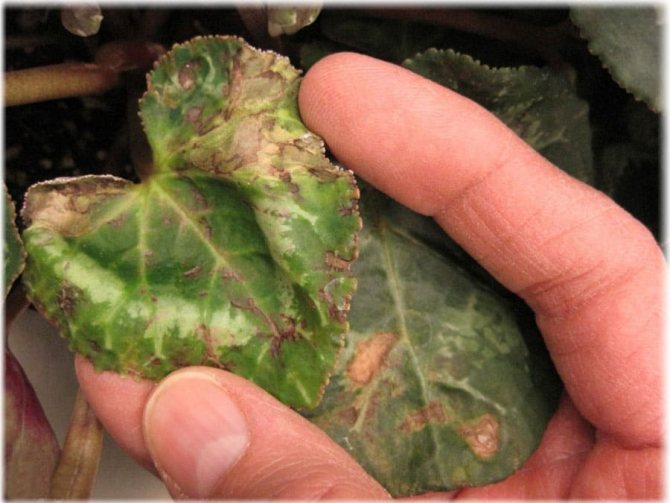

- Brittle stems indicate the appearance of the grape weevil. Check the soil regularly for small, round, cream colored larvae.
- Yellow leaves - use hard water when watering.
- Petioles and peduncles rot, the plant dies - over-watering, especially when used overhead.
- Tuber rots - water stagnates in a pan, or pot. Use bottom watering, then drain excess water from the sump.
- Gray rot appears - excess moisture in the room with poor ventilation.
- The leaves are deformed, become lethargic and small in size, the flowers wither, the buds lose their shape and fall off - the defeat of the cyclamen by the cyclamen tick. It will practically not be possible to withdraw, the plant is destroyed in order to avoid infection.
- The flower withers, the leaves turn yellow and fall off - direct sunlight, the temperature in the room is above 17 degrees, or the air is too dry.
Precautions
The cyclamen tubers contain poison, which, when it gets on the mucous membrane, can provoke an upset stomach, vomiting, diarrhea, and convulsions.
Description of the flower
Cyclamen is a small herbaceous perennial plant with a thickened root. It is appreciated for its original appearance. The rounded or heart-shaped leaves are decorated with an interesting pattern. Flowers bloom on long stalks, one on each.


Currently, there are about twenty species of this plant. And if initially only red and white cyclamen were known, now, as a result of selection, various hybrid varieties with corrugated and multi-colored frills, two-color, with a border, veins, etc., have been created.
Distinctive features of the European cyclamen


There are several signs by which the European white cyclamen can be easily distinguished from the Persian.
- European varieties do not shed their leaves during dormancy. Unlike the "Persians", they simply stop growing.
- In European varieties, the leaves and flowers are much smaller, as a result of which the whole plant as a whole is more compact.
- The lighter its color, the thinner and more pleasant the aroma of the flower. Therefore, the white cyclamen - European is especially appreciated by flower growers.
- In the European cyclamen, the reverse side of the leaves is painted in a soft violet hue.
- The roots grow all over the tuber. Plants of this species form many daughter bulbs, due to which they reproduce well.
Consider the most famous varieties of this plant with white flowers.
Album
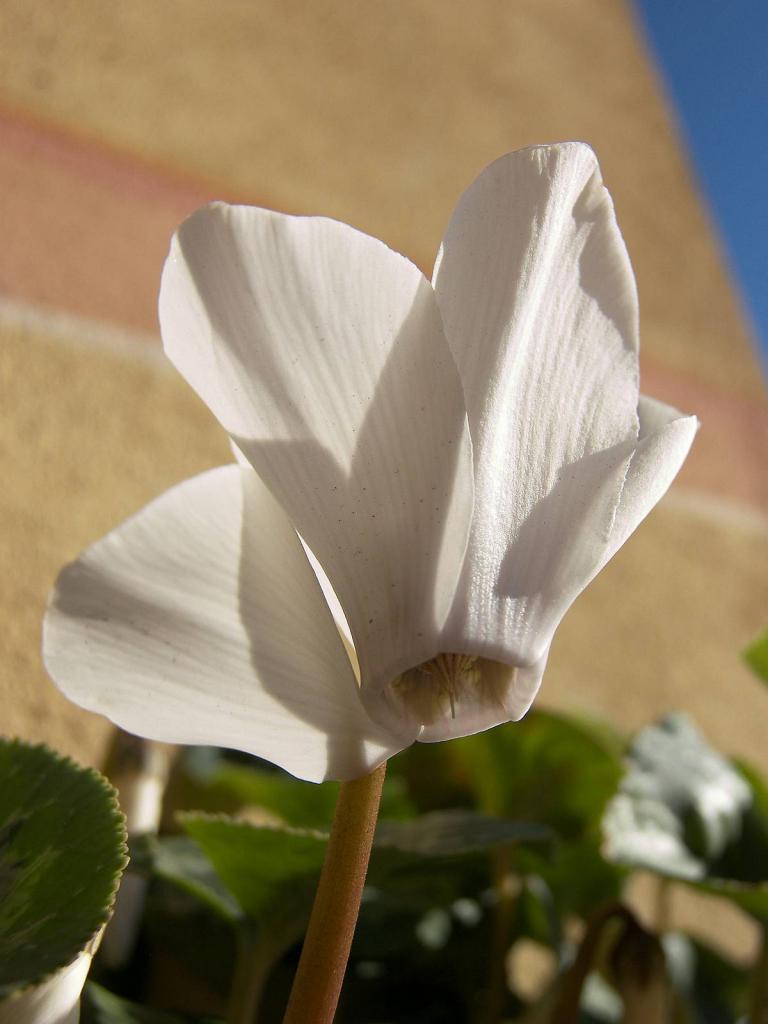

This variety of European cyclamen is cultivated as a garden plant. It blooms in spring. Its delicate white flowers bloom on peduncles up to thirty centimeters high and have a rather original structure. Their petals expand sharply at the very base. This species is characterized by very beautiful silvery marble leaves that appear in the fall and winter under the snow.
Poisonous or not
Many are familiar with this flower and prefer to keep it at home. It is in great demand. Someone grows it on a windowsill, in a garden plot, while someone enjoys its appearance in natural places of growth. As a result of this popularity, many are wondering whether cyclamens are poisonous or not.
Why cyclamen does not bloom: the main reasons and methods of resuscitation
Experienced gardeners consider this flower not only beautiful, but also an amazing way, combining poisonous and medicinal properties. The funds that contain this plant are successfully used to combat many diseases.
Since the root of cyclamen contains a glycoside, the plant is poisonous and should be used for medicinal purposes only under strict medical supervision.
Note! It is strictly forbidden to use a flower on your own for treatment, since even low dosages with a non-professional approach can lead to negative consequences.
Briefly about the history of appearance
The variety was first discovered on snow-capped peaks in Israel. In England, the plant began to be grown in pots in the middle of the 19th century, despite the fact that it was considered wild. In 1650, the plant came to Europe and from that moment began to be in demand, which is rapidly progressing to this day. Today you can find different colors. They can be one-color, two-color, with a border, multi-color frill, and this is not the limit. Breeders are constantly working on the development of new varieties and shades.


